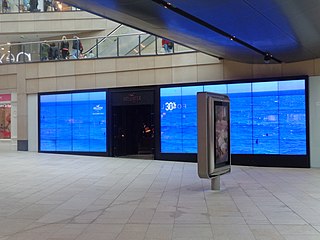Related Research Articles

Advertising is the practice and techniques employed to bring attention to a product or service. Advertising aims to put a product or service in the spotlight in hopes of drawing it attention from consumers. It is typically used to promote a specific good or service, but there are wide range of uses, the most common being the commercial advertisement.

Sales are activities related to selling or the number of goods sold in a given targeted time period. The delivery of a service for a cost is also considered a sale. A period during which goods are sold for a reduced price may also be referred to as a "sale".

Telemarketing is a method of direct marketing in which a salesperson solicits prospective customers to buy products, subscriptions or services, either over the phone or through a subsequent face to face or web conferencing appointment scheduled during the call. Telemarketing can also include recorded sales pitches programmed to be played over the phone via automatic dialing.
Permission marketing is a type of advertising in which the people who are supposed to see the ads can choose whether or not to get them. This marketing type is becoming increasingly popular in digital marketing. Seth Godin first introduced the concept in his book “Permission Marketing: Turning Strangers Into Friends, And Friends Into Customers.”
Sales promotion is one of the elements of the promotional mix. The primary elements in the promotional mix are advertising, personal selling, direct marketing and publicity/public relations. Sales promotion uses both media and non-media marketing communications for a pre-determined, limited time to increase consumer demand, stimulate market demand or improve product availability. Examples include contests, coupons, freebies, loss leaders, point of purchase displays, premiums, prizes, product samples, and rebates.

In promotion and advertising, a testimonial or show consists of a person's written or spoken statement extolling the virtue of a product. The term "testimonial" most commonly applies to the sales-pitches attributed to ordinary citizens, whereas the word "endorsement" usually applies to pitches by celebrities. Testimonials can be part of communal marketing.

Direct marketing is a form of communicating an offer, where organizations communicate directly to a pre-selected customer and supply a method for a direct response. Among practitioners, it is also known as direct response marketing. In contrast to direct marketing, advertising is more of a mass-message nature.
Junk faxes are a form of telemarketing where unsolicited advertisements are sent via fax transmission. Junk faxes are the faxed equivalent of spam or junk mail. Proponents of this advertising medium often use the terms broadcast fax or fax advertising to avoid the negative connotation of the term junk fax. Junk faxes are generally considered to be a nuisance since they waste toner, ink and paper in fax machines.
Marketing communications refers to the use of different marketing channels and tools in combination. Marketing communication channels focus on how businesses communicate a message to its desired market, or the market in general. It is also in charge of the internal communications of the organization. Marketing communication tools include advertising, personal selling, direct marketing, sponsorship, communication, public relations, social media, customer journey and promotion.
Email marketing is the act of sending a commercial message, typically to a group of people, using email. In its broadest sense, every email sent to a potential or current customer could be considered email marketing. It involves using email to send advertisements, request business, or solicit sales or donations. Email marketing strategies commonly seek to achieve one or more of three primary objectives: build loyalty, trust, or brand awareness. The term usually refers to sending email messages with the purpose of enhancing a merchant's relationship with current or previous customers, encouraging customer loyalty and repeat business, acquiring new customers or convincing current customers to purchase something immediately, and sharing third-party ads.

A sweepstake is a type of contest where a prize or prizes may be awarded to a winner or winners. Sweepstakes began as a form of lottery that were tied to products sold. In response, the FCC and FTC refined U.S. broadcasting laws. Under these laws sweepstakes became strictly "No purchase necessary to enter or win" and "A purchase will not increase your chances of winning", especially since many sweepstakes companies skirted the law by stating only "no purchase necessary to enter", removing the consideration to stop abuse of sweepstakes. Today, sweepstakes in the United States are used as marketing promotions to reward existing consumers and to draw attention to a product. By definition, the winner is determined by pure random chance rather than skill.
Email filtering is the processing of email to organize it according to specified criteria. The term can apply to the intervention of human intelligence, but most often refers to the automatic processing of messages at an SMTP server, possibly applying anti-spam techniques. Filtering can be applied to incoming emails as well as to outgoing ones.

Personal selling occurs when a sales representative meets with a potential client for the purpose of transacting a sale. Many sales representatives rely on a sequential sales process that typically includes nine steps. Some sales representatives develop scripts for all or part of the sales process. The sales process can be used in face-to-face encounters and in telemarketing.
The term opt-out refers to several methods by which individuals can avoid receiving unsolicited product or service information. This option is usually associated with direct marketing campaigns such as e-mail marketing or direct mail. A list of those who have opted out is called a Robinson list.
In marketing, lead generation is the initiation of consumer interest or inquiry into the products or services of a business. A lead is the contact information and, in some cases, demographic information of a customer who is interested in a specific product or service.
Mobile marketing is a multi-channel online marketing technique focused at reaching a specific audience on their smartphones, feature phones, tablets, or any other related devices through websites, e-mail, SMS and MMS, social media, or mobile applications. Mobile marketing can provide customers with time and location sensitive, personalized information that promotes goods, services, appointment reminders and ideas. In a more theoretical manner, academic Andreas Kaplan defines mobile marketing as "any marketing activity conducted through a ubiquitous network to which consumers are constantly connected using a personal mobile device".

Digital marketing is the component of marketing that uses the Internet and online-based digital technologies such as desktop computers, mobile phones, and other digital media and platforms to promote products and services. Its development during the 1990s and 2000s changed the way brands and businesses use technology for marketing. As digital platforms became increasingly incorporated into marketing plans and everyday life, and as people increasingly used digital devices instead of visiting physical shops, digital marketing campaigns have become prevalent, employing combinations of search engine optimization (SEO), search engine marketing (SEM), content marketing, influencer marketing, content automation, campaign marketing, data-driven marketing, e-commerce marketing, social media marketing, social media optimization, e-mail direct marketing, display advertising, e-books, and optical disks and games have become commonplace. Digital marketing extends to non-Internet channels that provide digital media, such as television, mobile phones, callbacks, and on-hold mobile ringtones. The extension to non-Internet channels differentiates digital marketing from online marketing.
Next-best-action marketing, as a special case of next-best-action decision-making, is a customer-centric marketing paradigm that considers the different actions that can be taken for a specific customer and decides on the ‘best’ one. The Next Best Action is determined by the customer's interests and needs on one hand, and the marketing organization's business objectives and policies on the other. This is in sharp contrast to traditional marketing approaches that first create a proposition for a product or service and then attempt to find interested and eligible prospects for that proposition. The practice, direct marketing, is typically automated in the form of a campaign management tool, is often product-centric, and usually always marketing-centric.
A sales letter is a piece of direct mail which is designed to persuade the reader to purchase a particular product or service in the absence of a salesman or saleswoman. It has been defined as "A form of direct mail in which an advertiser sends a letter to a potential customer." It is distinct from other direct mail techniques, such as the distribution of leaflets and catalogues, as the sales letter typically sells a single product or product line, and further tends to be mainly textual as opposed to graphics-based, although video sales letters have become increasingly popular. It is typically used for products or services which, due to their price, are a considered purchase at medium or high value. A sales letter is often, but not exclusively, the last stage of the sales process before the customer places an order, and is designed to ensure that the prospect is committed to becoming a customer.
Real-time marketing is marketing performed "on-the-fly" to determine an appropriate or optimal approach to a particular customer at a particular time and place. It is a form of market research inbound marketing that seeks the most appropriate offer for a given customer sales opportunity, reversing the traditional outbound marketing which aims to acquire appropriate customers for a given 'pre-defined' offer. The dynamic 'just-in-time' decision making behind a real-time offer aims to exploit a given customer interaction defined by website clicks or verbal contact centre conversation.
References
- ↑ "Basic Definitions: Advertising, Marketing, Promotion, Public Relations, Publicity, and Sales". Managementhelp.org. Retrieved 2010-12-23.
- ↑ McNamara, Carter. "Marketing - A Commonly Misunderstood Term" . Retrieved April 19, 2009.
- 1 2 Mirna Bard, NuReachGlobal, 21/03/09
- ↑ "telemarketing definition and meaning". Investorwords.com. Archived from the original on 2017-06-08. Retrieved 2010-12-23.
- ↑ Interruption marketing doesn't work
- ↑ "direct mail definition". wordnet.princeton.edu. Retrieved 2010-12-23.
- ↑ "Outbound Marketing - Traditional Isn't Always Best". WordStream. 2010-04-14. Retrieved 2010-12-23.
- ↑ "Email Blast Definition - Direct Marketing Glossary". Marigoldtech.com. Retrieved 2010-12-23.
- 1 2 3 "Inbound Marketing vs. Outbound Marketing Note that the article uses the ambiguous terms inbound and outbound marketing.
- ↑ "Outbound Marketing Traditional is not always best
- ↑ Halligan, Brian (2010) Inbound Internet Marketing Blog
- ↑ "Inbound Marketing vs. Outbound Marketing